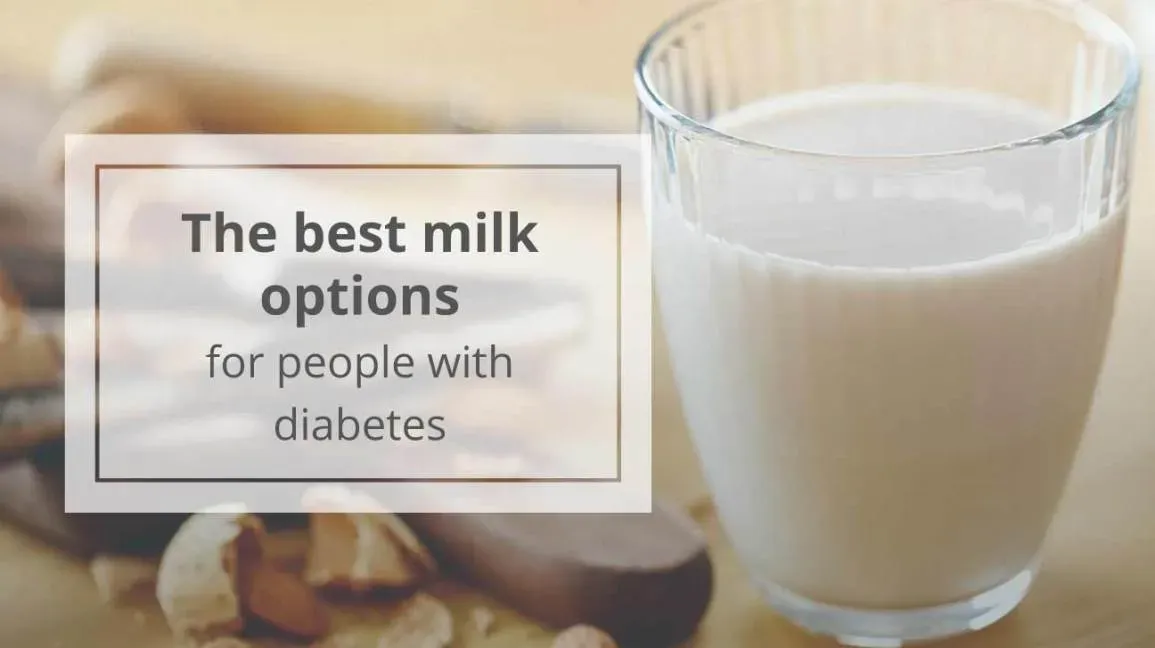Table of Contents
If you're living with diabetes, you probably spend a fair bit of time thinking about what you eat and drink. Every choice feels like it matters, and honestly, it does. Milk often pops up in these discussions. Is it okay? How much? What kind? There's a lot of conflicting advice out there, and it can feel overwhelming trying to figure out what's best for your blood sugar.
Understanding Milk's Role in a Diabetes Meal Plan

Understanding Milk's Role in a Diabetes Meal Plan
It's All About the Carbs, Mostly
Look, when you're managing diabetes, your primary concern with most foods and drinks is how they'll mess with your blood sugar. Milk, despite its wholesome image, contains carbohydrates, primarily in the form of lactose, which is a natural sugar. These carbs hit your bloodstream and, well, you know the drill – they raise your blood glucose levels. This doesn't mean milk is inherently "bad," but it does mean you can't just guzzle it down without accounting for those carbs in your daily total. Think of it like any other food with carbs; it requires planning.
More Than Just Sugar Water
Beyond the carbohydrate count, milk actually brings some decent nutrition to the table. It's a good source of calcium, which is crucial for bone health, especially as you age. You also get protein, which can help you feel full and has less of an immediate impact on blood sugar compared to pure carbs. Many types of milk are fortified with Vitamin D, another important nutrient that many people don't get enough of. So, while you're watching the carbs, it's worth acknowledging the other benefits it might offer.
- Calcium for strong bones
- Protein for fullness and muscle
- Vitamin D (often added)
- Some other vitamins and minerals
Fitting Milk into Your Daily Intake
Successfully including milk in a diabetes meal plan boils down to awareness and portion control. It's not about banning milk, but about fitting its carbohydrate load into your overall daily carb budget. If you plan to have a glass, you might need to adjust the carbs in other parts of your meal or snack. This is where counting carbohydrates becomes really useful. You can work with a dietitian to figure out how milk fits into your specific plan, ensuring you get the nutrients without sending your blood sugar on a roller coaster.
Breaking Down the Nutrition: Is Low Fat Milk Good for Diabetes?
Breaking Down the Nutrition: Is Low Fat Milk Good for Diabetes?
let's get down to the nitty-gritty numbers, because that's where the rubber meets the road with diabetes management. The question of whether low fat milk is good for diabetes often hinges on how it stacks up nutritionally against its full-fat cousin and other options. The main difference, unsurprisingly, is the fat content. Whole milk has significantly more saturated fat and total calories. Low-fat (2%) and skim (fat-free) milk strip away most of that fat. But here's the kicker that sometimes trips people up: the carbohydrate content, specifically lactose, remains largely the same across all types of dairy milk. So, while you're cutting fat and calories with low-fat versions, you're not necessarily cutting the primary driver of blood sugar spikes from the milk itself.
LowFat Dairy vs. Plant Milks: Which is Better for Diabetes?

LowFat Dairy vs. Plant Milks: Which is Better for Diabetes?
The Rise of the Plant-Based Alternatives
so we've talked about low fat milk and its carb situation. But walk into any grocery store these days, and the dairy aisle has exploded. It's not just cow's milk anymore; you've got almond, soy, oat, flax, cashew, rice – the list goes on. For people managing diabetes, these plant-based alternatives look tempting, often marketed as "healthier." But are they automatically better than, say, low fat milk when it comes to blood sugar control or getting key nutrients?
It's not a simple yes or no. Each plant milk has its own nutritional profile, and crucially, how they are processed and what's added makes a massive difference. Comparing them directly to low fat milk requires squinting at the nutrition labels, because the carb counts and added sugars can swing wildly.
Checking the Numbers: Carbs and Sugar Content
This is where you need to be a detective. While low fat milk has a fairly consistent amount of natural sugar (lactose) and carbs per serving, plant milks are all over the map. Unsweetened almond milk, for example, is typically very low in carbs and calories, often much lower than low fat dairy milk. Soy milk can be similar in protein to cow's milk but varies in carbs depending on whether it's sweetened.
Oat milk, despite its popularity, can be surprisingly high in carbohydrates compared to low fat milk or almond milk. Rice milk often has even more carbs and less protein. The absolute critical thing to check on the label is the "Total Carbohydrate" and "Added Sugars" lines. A lot of plant milks, even some labeled "original," have sugar dumped into them to make them taste better. That added sugar is what you really want to avoid when managing diabetes.
Milk Type (1 cup serving) | Calories | Total Carbs (g) | Added Sugars (g) | Protein (g) |
|---|---|---|---|---|
Skim Cow's Milk | 80 | 12 | 0 | 8 |
Low Fat (2%) Cow's Milk | 120 | 12 | 0 | 8 |
Unsweetened Almond Milk | 30-40 | 1-2 | 0 | 1 |
Unsweetened Soy Milk | 80-90 | 3-4 | 0 | 7-8 |
Oat Milk (Original) | 120-130 | 16-17 | 7-8 | 3 |
Beyond Carbs: Fortification and Other Nutrients
Carbs aren't the whole story, though. Remember how low fat milk offers calcium and Vitamin D? Many plant milks are fortified with these nutrients to be comparable, but you need to check the label to be sure. Some might not be fortified at all, or might have lower levels. Protein content also varies wildly. Soy milk is usually the closest to cow's milk in protein, while almond and rice milks are often very low. If you rely on milk for protein, this is an important distinction.
Ultimately, the "better" choice between low fat dairy and a plant milk for diabetes depends heavily on the specific plant milk product (always choose unsweetened!) and your individual nutritional needs and preferences. Neither is inherently a magic bullet, and both require you to pay attention to their carbohydrate and calorie contribution to your diet.
Making Milk Work: Practical Steps to Include Milk in Your Diabetes Diet

Making Milk Work: Practical Steps to Include Milk in Your Diabetes Diet
Making Milk Work: Practical Steps to Include Milk in Your Diabetes Diet
Alright, so you've waded through the carbs, the fat content, and the jungle of plant-based options. The good news is, you don't necessarily have to swear off milk entirely just because you have diabetes. The trick is integrating it smartly into your overall eating plan. It's not a free beverage station; it's a food item with calories and carbohydrates that need to be accounted for. Think of it as budgeting – you have a certain amount of carbs you can spend each day, and milk uses up some of that budget.
The absolute first step, and I can't stress this enough, is reading the nutrition label. Every single time. This applies whether you're grabbing a carton of low-fat dairy milk or trying a new brand of almond milk. You need to know the total carbohydrates per serving, and just as important, the amount of added sugars. Unsweetened versions are almost always the better choice for blood sugar control. Also, check the protein and fiber content (though fiber is usually low in milk) and see if it's fortified with calcium and Vitamin D, especially if you're using it as a source for those nutrients.
Here's what to scan for on that carton:
- Serving Size (it dictates everything else)
- Total Carbohydrates (this is your main number for blood sugar)
- Added Sugars (aim for zero if possible)
- Protein (helps with fullness)
- Calcium and Vitamin D fortification (important for bones)
Consider when and how you're drinking it. Downing a glass of milk by itself on an empty stomach might cause a quicker blood sugar rise than having it with a meal that includes protein, fat, and fiber. For example, milk with a balanced breakfast containing eggs and whole-grain toast will likely have a different impact than milk with a sugary pastry. Pairing helps slow down digestion and the absorption of those carbs.
Think about where milk fits into your day. Are you pouring a big bowl of cereal? That's a double whammy of carbs unless you choose a very low-carb cereal. Are you adding it to coffee? A splash is probably fine; half the mug might require adjustment. For coffee or tea, a little bit of heavy cream (which has almost no carbs) or a small amount of unsweetened plant milk might be a better call than loading up on carb-containing milk.
How does milk affect *your* blood sugar specifically? The only way to truly know is to test.
Test your blood sugar before you consume milk and then again about two hours afterward. Keep a log. See how a standard serving of low-fat milk or your chosen plant milk impacts your levels. This personal data is far more valuable than any general guideline because everyone's body responds slightly differently. You might find a half-cup is fine, but a full cup sends you too high. Experiment within safe limits and track the results.
Finally, don't try to figure all of this out in a vacuum. A registered dietitian who specializes in diabetes can be incredibly helpful. They can look at your entire diet, your medications, your activity level, and your blood sugar patterns to help you figure out exactly how much milk (and what kind) fits safely and beneficially into your personalized plan. They can provide tailored advice that beats generic internet articles any day.
Making Informed Choices About Milk and Diabetes
So, is low fat milk good for diabetes? It's not a simple yes or no. Low-fat milk can fit into a diabetes meal plan, but it requires attention to portion size and overall carbohydrate intake. It provides valuable nutrients like calcium and protein. However, like any food containing carbohydrates, it will affect blood sugar levels. Unsweetened plant-based options might offer lower carb alternatives, but check labels for added sugars and fortification. Ultimately, managing diabetes involves balancing many factors, and milk is just one piece of that puzzle. Pay attention to how different foods impact you individually, and don't hesitate to discuss your choices with a healthcare provider or a registered dietitian. They can help tailor recommendations to your specific needs and goals, which beats guessing every time.
